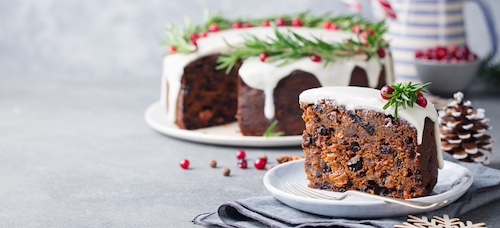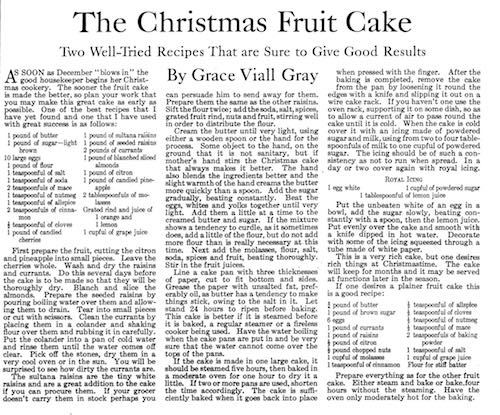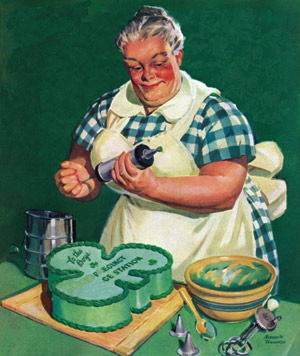105-Year-Old Fruitcake Recipes
Equally loved and loathed, the fruit-and-nut loaf come Christmas is as ubiquitous as hand-knitted Rudolph sweaters covered in jingle bells and puff paint. Here are two vintage recipes, circa 1912, sure to please the fruit cake lovers (and maybe turn the hearts of the haters) at the ugly Christmas sweater party this year.
Holiday tip: Along with your cake, offer your host a copy of Nora Ephron’s Christmas comedy Mixed Nuts — with Madeline Kahn, Steve Martin, and a fruit cake disaster that leads to romance.
—
The Christmas Fruit Cake:Two Well-Tried Recipes That Are Sure to Give Good Results
Originally published in The Country Gentleman, December 14, 1912
As soon as December “blows in” the good housekeeper begins her Christmas cookery. The sooner the fruit cake is made the better, so plan your work that you may make this great cake as early as possible. One of the best recipes that I have yet found and one that I have used with great success is as follows:
- 1 pound of butter
- 1 pound of sugar — light brown
- 10 large eggs
- 1 pound of flour
- 1 teaspoonful of salt
- 1 teaspoonful of mace
- 1 teaspoonful of nutmeg
- 1 teaspoonful of allspice
- 1 teaspoonful of cinnamon
- 1/2 teaspoonful of cloves
- 1 pound of candied cherries
- 1 pound of sultana raisins
- 1 pound of seeded raisins
- 2 pounds of currants
- 1 pound of blanched sliced almonds
- 1 pound of citron
- 1 pound of candied pineapple
- 2 tablespoonfuls of molasses
- Grated rind and juice of 1 orange and 1 lemon>
- 1 cupful of grape juice
First prepare the fruit, cutting the citron and pineapple into small pieces. Leave the cherries whole. Wash and dry the raisins and currants. Do this several days before the cake is to be made so that they will be thoroughly dry. Blanch and slice the almonds. Prepare the seeded raisins by pouring boiling water over them and allowing them to drain. Tear into small pieces or cut with scissors. Clean the currants by placing them in a colander and shaking flour over them and rubbing it in carefully. Put the colander into a pan of cold water and rinse them until the water comes off clear. Pick off the stones, dry them in a very cool oven or in the sun. You will be surprised to see how dirty the currants are.
The sultana raisins are the tiny white raisins and are a great addition to the cake if you can procure them. If your grocer doesn’t carry them in stock perhaps you can persuade him to send away for them. Prepare them the same as the other raisins. Sift the flour twice; add the soda, salt, spices, grated fruit rind, nuts, and fruit, stirring well in order to distribute the flour.
Cream the butter until very light, using either a wooden spoon or the hand for the process. Some object to the hand, on the ground that it is not sanitary, but if mother’s hand stirs the Christmas cake that always makes it better. The hand also blends the ingredients better and the slight warmth of the hand creams the butter more quickly than a spoon. Add the sugar gradually, beating constantly. Beat the eggs, whites and yolks together until very light. Add them a little at a time to the creamed butter and sugar. If the mixture shows a tendency to curdle, as it sometimes does, add a little of the flour, but do not add more flour than is really necessary at this time. Next add the molasses, flour, salt, soda, spices and fruit, beating thoroughly. Stir in the fruit juices.
Line a cake pan with three thicknesses of paper, cut to fit bottom and sides. Grease the paper with unsalted fat, preferably oil, as butter has a tendency to make things stick, owing to the salt in it. Let stand 24 hours to ripen before baking. This cake is better if it is steamed before it is baked, a regular steamer or a fireless cooker being used. Have the water boiling when the cake pans are put in and be very sure that the water cannot come over the tops of the pans.
If the cake is made in one large cake, it should be steamed five hours, then baked in a moderate oven for one hour to dry it a little. If two or more pans are used, shorten the time accordingly. The cake is sufficiently baked when it goes back into place when pressed with the finger. After the baking is completed, remove the cake from the pan by loosening it round the edges with a knife and slipping it out on a wire cake rack. If you haven’t one use the oven rack, supporting it on some dish, so as to allow a current of air to pass round the cake until it is cold.
When the cake is cold cover it with an icing made of powdered sugar and milk, using from two to four tablespoonfuls of milk to one cupful of powdered sugar. The icing should be of such a consistency as not to run when spread. In a day or two, cover again with royal icing.

Royal Icing
- 1 egg white [If the idea of eating raw egg makes you queasy, sub 2 teaspoons meringue powder and 2 tablespoons water for egg.]
- 1 cupful of powdered sugar
- 1 tablespoonful of lemon juice
Put the unbeaten white of an egg in a bowl, add the sugar slowly, beating constantly with a spoon, then the lemon juice. Put evenly over the cake and smooth with a knife dipped in hot water. Decorate with some of the icing squeezed through a tube made of white paper.
This is a very rich cake, but one desires rich things at Christmastime. The cake will keep for months and it may be served at functions later in the season.
If one desires a plainer fruit cake this is a good recipe:
- 3/4 pound of butter
- 1 pound of brown sugar 6 eggs 1 pound of currants 1 pound of raisins
- 1/2 pound of citron
- 1 cupful of molasses
- 1 teaspoonful of cinnamon
- 1/2 teaspoonful of allspice
- 1/2 teaspoonful of cloves
- 1/2 teaspoonful of nutmeg
- 1/2 teaspoonful of mace
- 2 teaspoonfuls of baking powder
- 1 teaspoonful of salt
- 1 cupful of grape juice
- Flour for stiff batter
Prepare everything as for the other fruit cake. Either steam and bake or bake four hours without the steaming. Have the oven only moderately hot for the baking.

March/April 2013 Limerick Laughs Contest Winner and Runners-Up

I’m making this cake for a few
Of all of our brave lads in blue,
For Casey and Ryan
And Patrick O’Brien
And all of the other cops too!
—Philip Lindal, Yale, Michigan
Congratulations to Philip Lindal! For his poem describing the illustration by Albert W. Hampson, Philip wins a monetary award—and our gratitude for a job well done. If you’d like to enter the Limerick Laughs Contest for our upcoming issue, you can submit your limerick via the entry form here.
Of course, Philip’s limerick wasn’t the only one we liked! Here are some of our favorite runners-up, in no particular order:
Old, gray, but still a bit frisky,
Not afraid to do something risky,
She’d win their hearts over
When inside the clover
They find the fine pint o’ whiskey.—Ken Elinsky, Solon, Ohio
Had a cake, made from scratch, it was true,
For the boys, who worked hard, wearing blue.
As I tripped at the door
And the cake hit the floor,
There was nothing to say but “Boohoo!”—JoAnn White, Watertown, New York
Ms. O’Malley did make a great cake
For the boys at the station to take.
And her boy in the clink
Should be out in a blink.
One bite, and they’d know their mistake.—Mark Blackwell, Mt. Pleasant, South Carolina
This woman, though not very lean,
Is this year’s St. Patrick’s Day queen.
Does her cake have a hint
Of lime or of mint?
Who cares, just as long as it’s green.—Neal Levin, Bloomfield Hills, Michigan
My neighbor, Miss Brigid O’Connor,
Baked shamrocks in Saint Paddy’s honor.
The pretty green icing
Turned out quite enticing,
Since good fairies’ spells were upon her.—Caroline Sposto, Memphis, Tennessee
Oh, she was an expert cake maker,
An icer as well as a baker.
But seeing her size,
We can all surmise
That she was an often partaker.—Cornelius Jonker; Grand Rapids, Michigan
The police well-deserve this cake treat.
Her inscription sure made it complete.
This shamrock design
Will suit the cops fine,
But it’s almost too pretty to eat!—Mary Collins Ryan; Bradford, Pennsylvania
A labor of love, this creation,
For “my boys” down at the station.
Takes hours to make
This type of cake,
But I am so proud of their dedication.—Virginia Wilson; Port Orange, Florida